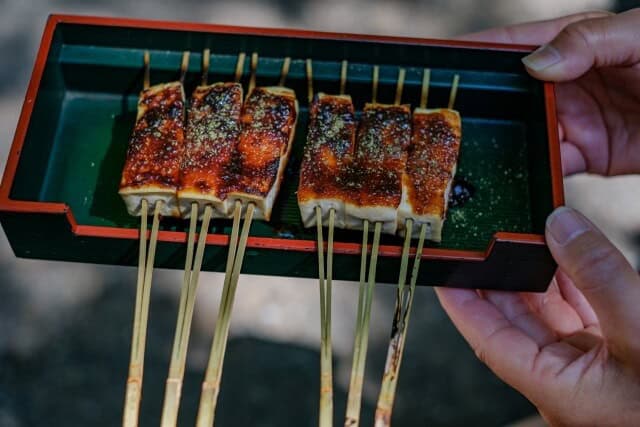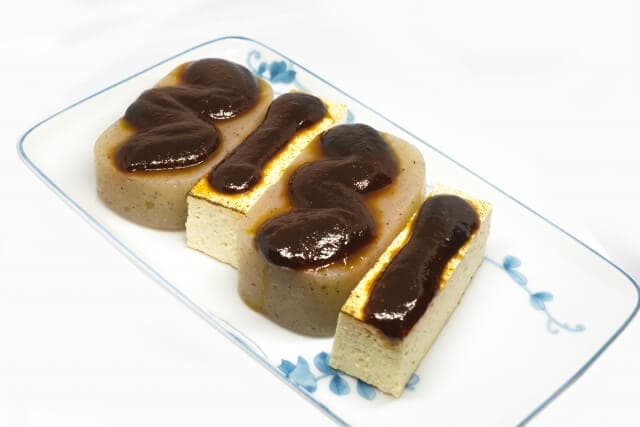Curious about the mouthwatering flavors of Japanese cuisine? Look no further than tofu dengaku, a delectable dish that tantalizes taste buds with its sweet and savory goodness. Originating in Japan, tofu dengaku offers a delightful combination of grilled tofu and a flavorful miso glaze, making it a beloved part of Japanese culinary heritage. Now, let’s get started.
What is Tofu dengaku?

Tofu dengaku is a traditional Japanese dish where tofu is grilled or broiled and then coated with a sweet and savory miso glaze. The term “dengaku” refers to a style of cooking where food is skewered and grilled, often with a miso-based sauce. In the case of this dish, the tofu is typically cut into cubes or slices, skewered, grilled until lightly browned, and then brushed with a sauce made from miso, sugar, mirin (sweet rice wine), and sometimes soy sauce. This dish is popular in Japanese cuisine for its delicious combination of flavors and textures, as well as its simplicity of preparation.
Tofu dengaku History

In regions like northern Japan’s Iwate Prefecture where rice cultivation is challenging due to a cool climate, soybeans have historically thrived, leading to a culture centered around tofu, celebrated as the “meat of the field” for its nutritional value. Traditionally handmade at home and shared with neighbors, tofu has become a staple with versatile cooking applications, including simmering, soups, and hot pots, often preserved by freezing through winter. Tofu dengaku, a grilled tofu dish skewered on bamboo and enjoyed with garlic miso, holds cultural significance in various regions.
In Shiga Prefecture, deeply rooted religious practices have incorporated tofu into Buddhist vegetarian cuisine, grilling tofu skewers and dipping them in miso. The tradition of tofu dengaku extends to festivals and events, with its origins traced back to ancient farming communities and their Dengaku Dance rituals, evolving into a culinary specialty synonymous with regional identity, incorporating not only tofu but also an array of ingredients like konnyaku, taro, and shiitake mushrooms.
Opportunities and seasons for enjoying

The tofu was traditionally crafted for special occasions, often accompanying simmered dishes. During the “Daikoku-sama’s New Year’s Eve” celebration in December, an array of soybean-based dishes, including “Tofu Dengaku,” were offered. Additionally, some eateries serve a variation of this dish called “Kinome Dengaku” during cherry blossom season, prepared with miso flavored with Japanese pepper.
Preservation and efforts for passing down traditions

While the tradition of homemade tofu continues from generation to generation, more families are adapting by pan-frying tofu and garnishing it with green onion miso or sansho miso. Additionally, tofu dengaku is now readily available in supermarkets, restaurants, and specialty stores, ensuring its accessibility and preservation.
Tofu dengaku calories and nutrients

The calories and nutrients per 100g of tofu dengaku are as follows:
Energy: 128kcal
Protein: 5.87g (23.48kcal)
Fat: 3.27g (29.43kcal)
Carbohydrate: 16.62g (66.48kcal)
Protein is a nutrient that is a building block for the body (skeletal muscles and internal organs). Carbohydrates provide fast-acting energy, while fats provide long-lasting energy. If you consume too much of any of the three macronutrients, they will be stored in your body as fat.
Tofu dengaku suitable for vegetarians and vegans

Tofu dengaku is a vegetarian and vegan-friendly dish as it primarily consists of tofu, which is made from soybeans. The miso-based glaze typically used for dengaku is also plant-based, making it suitable for those following vegetarian or vegan diets. Additionally, the dish can be customized by adjusting the seasoning to suit individual dietary preferences, ensuring that everyone can enjoy its delicious flavors without compromising their dietary choices.
Tofu dengaku FAQ
- How to savor?
-
Firm tofu is sliced into rectangles, skewered on bamboo sticks, grilled over charcoal, and enjoyed with garlic miso, which may also feature butterbur and Japanese pepper. Consuming it with grated radish is believed to aid digestion.
- Can tofu dengaku be prepared without grilling over charcoal?
-
While grilling this dish over charcoal imparts a smoky flavor and enhances its overall taste, it can still be prepared using alternative cooking methods. If you don’t have access to a charcoal grill, you can broil or bake the tofu in the oven until it’s lightly browned and then coat it with the miso glaze. Alternatively, you can pan-fry the tofu for a crispy texture before adding the glaze. Regardless of the cooking method, tofu dengaku remains a delightful dish with its sweet and savory flavors.
Tofu dengaku Recipe
Ingredients for 4 persons
| Tofu Dengaku Ingredients | Measurements |
|---|---|
| Firm tofu | 25g |
| [Green onion miso] Green onion | 55g |
| [Green onion miso] Miso | 100g |
| [Green onion miso] Sugar | 80g |
| Dengaku skewers | 4g |
How to make Tofu dengaku?
Cut the green onions into small pieces, grind them well in a mortar, add the miso and sugar, and mix.
Soak the dengaku skewers in water for about half a day.
Divide the tofu into 24 pieces, remove moisture with a cloth, and thread onto skewers.
Each piece of tofu sold at a tofu store in Nagahama City, Shiga Prefecture is cube-shaped. You can divide it into 24 pieces. The tofu sold at mass retailers today is smaller than this, so cut it into 8 to 12 pieces.
Heat the tofu on the stove until golden brown, then sear the other side. If you are making it in a frying pan or hot plate, roast it before inserting skewers into it.
Spread green onion miso on both sides of tofu, lightly toast, and serve.
Where to buy Tofu dengaku?
Takada Tofu Store (高田豆腐店)

A Japanese restaurant with a quaint Japanese atmosphere, serving dishes centred on tofu and yuba. Their Tofu Dengaku Gozen costs 1,298 yen. The luxurious lunch set includes miso dengaku using the famous tofu as the main dish, as well as vegetable rice, yuba soup, boiled okra, sesame tofu, pickled vegetables, salad, and dessert.
Ishibe-juku Dengaku Chaya (石部宿 田楽茶屋)

Here, you can take a look at the realistic inns and teahouses recreated at the History and Folklore Museum, and enjoy the famous Dengaku tofu at Dengaku Chaya, which was also painted by Hiroshige Utagawa. The miso on tofu dengaku has a rich and sweet taste. It has just the right balance to bring out the umami of the light-tasting tofu and let you feel the strong soybean flavor.
Mitsukeya (見付屋)

This restaurant operated as a tofu restaurant until 1970, and even after becoming a restaurant, we have continued to grill Tofu Dengaku, a local dish of this region, over charcoal for more than 100 years. It is spread with a miso mixture of Japanese pepper and green onion and grilled twice on both sides to create a rich flavor.
Final Thoughts

Next time you find yourself in Japan, don’t miss the chance to savor the delightful flavors of tofu dengaku. Whether you’re exploring the bustling streets of Tokyo or immersing yourself in the serene countryside, this traditional dish offers a taste of authentic Japanese cuisine. With its sweet miso glaze and tender tofu, this dish is a culinary experience not to be missed.
You can check some Japanese tofu dishes that we know you would like to try too.
















Comments